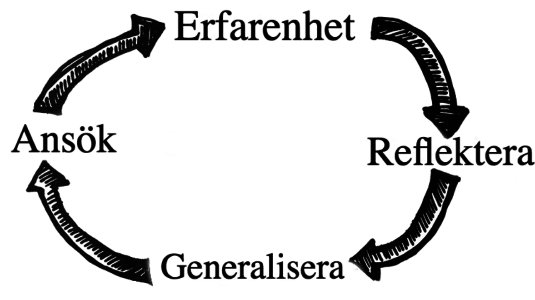Sometimes an “expert” stands in front of the room and delivers information to the participants. That’s treating our participants like they are empty cups we generously pour our expertise into.
A different model begins with people’s lived experiences and uses those to create new lessons and then immediately apply them. In that process, our goal is to tap into people’s wisdom—to make space for people to teach each other. This model is very consistent with activist values: encouraging people to trust their lived experiences, valuing self-respect, and learning from each other rather than only in one-direction. One name for that second model is the experiential learning cycle — because it starts with experience.

The four steps of the model of experiential education are:
- Experience, also called the activity, exercise, or learning tool,
- Reflection, in which participants think and feel about what they just did,
- Generalization, in which participants move from the level of immediate thoughts and feelings to the level of concepts and ideas. Here they can fit the ideas into how they see the world, even creating a new mental map which shows where things are and how things work,
- Application, in which participants try out their new learning through new behaviors.
Brazilian educator Paulo Freire said that we never learn simply through action, or through reflection, but through the relationship of action and reflection. One reason why methods of traditional education don’t work for training is that they usually get stuck on reflection and generalization and neglect the role of action in learning.
In the experiential education model we value action so the process begins with an action—the immediate experience (the exercise). This might be recalling a past experience or creating a brand new experience.
In generalization, facilitators elicit information including stories, theoretical concepts, sometimes even statistics if they’re present in the group –– all of which help participants look outside the immediate and into the conceptual. Facilitators then add appropriate stories and other information that touch other learning-points the group may not have offered. The facilitators offer theories to help participants push their conceptual ideas further.
The experiential education model is a circle, because the fourth step, application, becomes a new concrete experience which can then be followed by reflecting and generalizing, and applying something new.
For example, teaching a group about direct action strategy might go like this:
- Experience: (in small groups) What’s a time you successfully stood up to someone in authority? (This broad experience question allows everyone, even if they have never participated in a formal direct action, to participate and bring their expertise.)
- Reflection: What happened? What enabled you to be successful despite their authority over you? (Reflection is reflecting specifically on that past experience.)
- Generalisation: What are some key principles for standing up to authority? Make a list entitled: “What works when standing up to authority?” Ask: How can we apply these principles in our next upcoming action? (Because participants teach and share with each other, facilitators do not have to waste their time teaching concepts that participants already know. Instead they can focus on what is not present in the group, watching for concepts and stories outside of their experience and bringing in those.)
- Application: Role-play the upcoming action, strengthened with these new principles and insights.
Throughout the entire process of the experiential cycle, the underlying belief stays constant: teaching for empowerment, not dependency on outside expertise. That’s a process for real change!
(For more on how a facilitator can tap into the wisdom of a group, see cross-cultural trainings: some tips.)